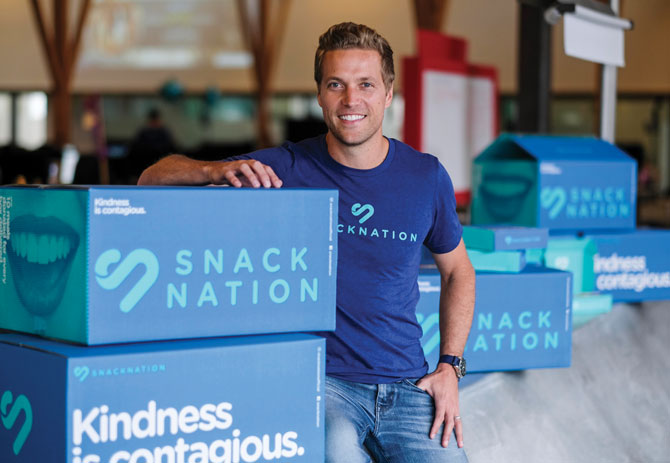SnackNation is a healthy-snack delivery company co-founded by Andy Mackensen and Sean Kelly, chief executive of the company. The Culver City-based enterprise does not make any of its own products – it packages snack boxes with items that have been custom-ordered by brand and size for its clientele.
Snack brands pay or provide items free of charge to be included in the boxes, which are peddled to companies that want to provide workers with a perk. SnackNation is responsible for the delivery of the “curated” packages to its customers, a roster that now includes some residential customers.
The four-year-old company last month acquired San Mateo-based data analytics firm EdgiLife Media Inc. and its Love With Food, a SnackNation competitor, for an undisclosed. That came two months after SnackNation closed a $12 million Series B round.
The company now has 150 employees, according to Kelly, who declined to offer specifics on sales or profits but sat with our Shwanika Narayan for a conversation about the company’s growth, challenges and possible exit strategies.
Edited excerpts of the discussion follow.
Question: What does SnackNation do?
Answer: We’re a tech-enabled snack marketplace. What that means is we work primarily with emerging snack brands that make healthy products, and we curate, customize and deliver those snacks to our customers, mostly offices, though we’re expanding into the home market.
What do you mean by tech-enabled?
We have a proprietary recommendation engine behind our snack curation.
Consumer’s snacking preferences today are more varied than ever, even if people follow the same dietary guidelines, our snacking preference would still be different. We measure everything from customers who prefer sweet, savory, combo, crunchy, soft snacks to rotation preferences, payments preferences, etc. We have all these data and insights into our clientele and market.
Why snacks?
Because almost everyone snacks. The majority of snacking occurs during the day at the office, and that’s what we consider to be an “engaged moment.” We look to distribute and deliver the best in healthy snacks to consumers at their most engaged moment.
What about schools? Engaged moments happen there, too.
Probably not. I had a company before SnackNation that placed vending machines filled with healthy snacks in schools. I came out of that business saying that the school sector is something I want to focus on from a charitable perspective, not from a revenue and profiting-generating perspective.
And how do you determine what’s healthy and what’s not?
We have a 16-panel taste test team. The products need to meet five criterion we’ve defined, and score 8 or above on all of them. We test around 100 to 200 new brands every single month, and our standards are similar to what Whole Foods has. [Whole Foods website claims the company features foods that are free of artificial preservatives, colors, flavors, sweeteners and hydrogenated fats].
How does the pricing work for brands? What do they need to do to partner up with you?
Brands are considered on a case-by-case basis. Some may want to be in the largest box possible, and are all in – and they may offer us free product and only get charged a relatively small fee. And then there are other brands that want placement into hundreds of offices and not thousands, and will be in boxes that have lower volumes, so pricing varies.
Who are the end customers? And what does pricing look like for them?
Mostly offices. Right now, we service 5,000 companies with 500,000 in-office consumers with boxes of various sizes that range from $99 to $350 per box. These companies are in technology, marketing and advertising, legal services and financial services fields. However, our home-based customers are rising too, boxes in this category start from $5 to $20.
How does your distribution to offices help emerging brands?
Over 90 percent of the time when a consumer and brand interaction happens in the office as result our delivery, it is a new one. We provide a discovery aspect to these brands. People can try it out. If you had to buy these in a store, there’s a good chance you’ll pass. But if it’s in the office and it’s getting provided for free by your employer, you’ll try it. It’s getting these emerging brands trial and awareness, which is the No. 1 most difficult thing for them to get on their own.
Can you give an example of a brand that benefitted from being a part of SnackNation box?
Field Trip Jerky. After coming into our network, it got a 600 percent increase in online sales. Customers sought it out, outside of their offices.
How have you set up your supply chain? Distribution?
We have a warehouse in Carson, California – everything else is third party logistics.
Do you have an exit strategy?
We do have different exit scenarios in mind, but that’s not our focus. I think we have an opportunity to change the way people snack and inspire more conscious food decisions. We’re focused on building a bigger company by working with businesses, consumers and brands. If I told you there was one exit scenario I was shooting for, I’d be lying.
– Shwanika Narayan

